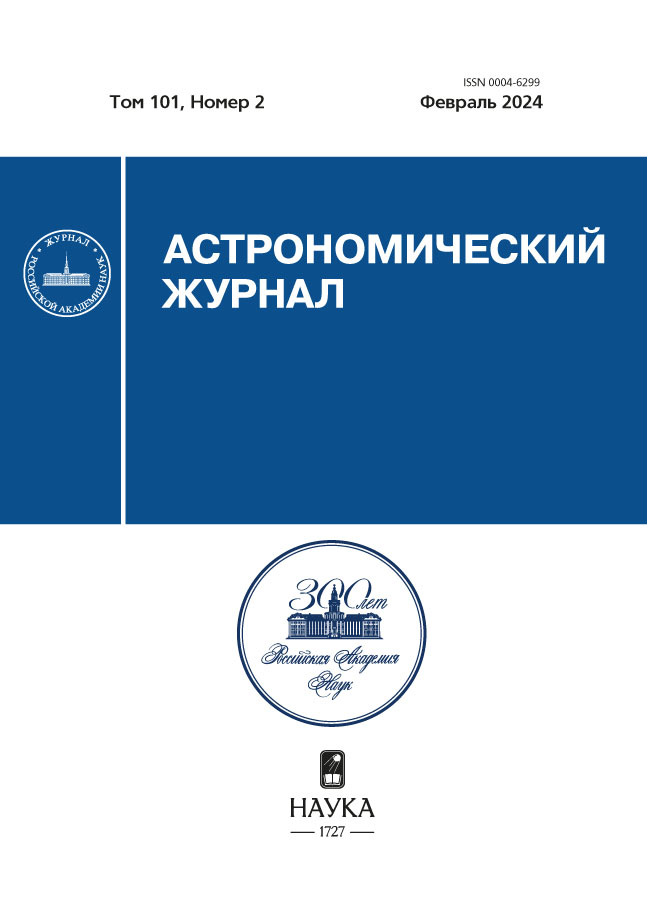Statistics of precipitable water vapour, optical thickness and cloud cover within the Northern part of Eurasia
- Authors: Khaikin V.В.1,2, Shikhovtsev A.Y.3, Mironov A.P.4,2
-
Affiliations:
- Special Astrophysical Observatory of the Russian Academy of Sciences
- Institute of Astronomy, Russian Academy of Sciences
- Institute of Solar-Terrestrial Physics, the Siberian Branch of the Russian Academy of Sciences
- Sternberg Astronomical Institute of Moscow State University
- Issue: Vol 101, No 2 (2024)
- Pages: 195-206
- Section: Articles
- URL: https://rjmseer.com/0004-6299/article/view/647647
- DOI: https://doi.org/10.31857/S0004629924020126
- EDN: https://elibrary.ru/KSBXIO
- ID: 647647
Cite item
Abstract
One of the most important tasks in astroclimatic studies of possible locations for the Eurasian Submillimeter Telescopes is estimating statistics of precipitable water vapour, optical thickness and cloud cover. In this paper, the statistics of precipitable water vapour and total cloud cover within Northern part of Eurasia are studied using ERA-5 reanalysis. Optical thickness statistics at a wavelength of 3 mm were obtained using the Liebe model from the ERA-5 reanalysis for the region where the BTA is located. The most favorable astroclimatic zones of Eurasia include Tibet and the Eastern Pamirs, certain regions of the Sayan Mountains, Altai and Mts within Dagestan. Also we verified the ERA-5 reanalysis data using radiosonde data, GNSS measurement data and radiometric measurements for 2021.
Full Text
About the authors
V. В. Khaikin
Special Astrophysical Observatory of the Russian Academy of Sciences; Institute of Astronomy, Russian Academy of Sciences
Email: Ashikhovtsev@iszf.irk.ru
Russian Federation, Nizhnij Arkhyz, Zelenchukskiy Region, Karachai-Cherkessian; Moscow
A. Yu. Shikhovtsev
Institute of Solar-Terrestrial Physics, the Siberian Branch of the Russian Academy of Sciences
Author for correspondence.
Email: Ashikhovtsev@iszf.irk.ru
Russian Federation, Irkutsk
A. P. Mironov
Sternberg Astronomical Institute of Moscow State University; Institute of Astronomy, Russian Academy of Sciences
Email: Ashikhovtsev@iszf.irk.ru
Russian Federation, Moscow; Moscow
References
- K. Akiyama, A. Alberdi, W. Alef et. al., Astrophys. J. Lett. 930, L12 (2022).
- Ю.Ю. Балега, Д.К-С. Батаев, Г.М. Бубнов и др., Доклады Российской академии наук. Физика, технические науки 502, 5 (2022).
- Ю.Ю. Балега, А.М. Барышев, Г.М. Бубнов и др., Известия высших учебных заведений. Радиофизика 633, 537 (2020).
- В. Кошелец, К. Рудаков, А. Худченко и др., Краткие сообщения по физике ФИАН 48, 47 (2021).
- K.I. Rudakov, A.V. Khudchenko, L.V. Filipenko, et. al., Applied Sciences 11, 10087 (2021).
- В.Б. Хайкин, А.Ю. Шиховцев, В.Е. Шмагин и др., Журнал Радиоэлектроники 7, 1684 (2022).
- X. Qian, Y. Yao, H. Wang et. al., Publ. Astron. Soc. Pacif. 132, 125003 (2020).
- S. Doeleman, L. Blackburn, J. Dexter, In Proceedings of the Bulletin of the American Astronomical Society 51, 256 (2019).
- A. Potekaev, N. Krasnenko, L. Shamanaeva, Atmosphere 12, 1347 (2021).
- Y.V. Molozhnikova, M.Y. Shikhovtsev, O.G. Netsvetaeva et al., Appl. Sci. 13, 8171 (2023).
- L.A. Bolbasova, E.K. Kopylov, Atmosphere 14, 1264 (2023).
- V.E Panchuk, V.L Afanas’ev, Astrophysical Bulletin 66, 2, 233–254 (2011).
- Iu.K. Bergner, A.V. Krat, M.A. Pogodin et al., Astrofizicheskie Issledovaniia 10, 52–60 (1978).
- L.A. Bolbasova, A.Yu. Shikhovtsev, S.A. Ermakov, Monthly Not. Roy. Astron. Soc. 520, 4336 (2023).
- A.W. Raymond, D. Palumbo, S.N. Paine, Astrophys. J. Suppl. Ser. 253, 5 (2021).
- A.Y. Shikhovtsev, P.G. Kovadlo, V.B. Khaikin et al., Remote Sensing 14, 6221 (2022).
- Г.Н. Ильин, В.Ю. Быков, В.Г. Стэмповский, А.М. Шишкин, Труды ИПА РАН 27, 210 (2013).
- Г.Н. Ильин, А.В. Троицкий, Известия высших учебных заведений. Радиофизика 60, 326 (2017).
- В.Ю. Быков, Г.Н. Ильин, Д.М. Караваев и др., Труды Военно-космической академии имени А.Ф. Можайского 680, 205 (2021).
- C.Б. Розанов, А.С. Завгородний, В.Л. Воронов, Труды ВРК-2022, 55 (2022).
- M. Bevis, S. Businger, T. A. Herring et. al., J. Geophys. Res. 97, 15787 (1992).
- M. Bevis, S. Businger, S. R. Chiswell et. al., J. Appl. Meteor. 33, 379 (1994).
- T.A. Herring, M.A. Floyd, R.W. King, S.C. McClusky Global Kalman filter VLBI and GPS Analysis Program, GLOBK Reference Manual, Release 10.6 (Department of Earth, Atmospheric and Planetary Sciences, Massachusetts Inst. Technol., Cambridge, MA, 54, 2018).
- J. Boehm, B. Werl, H. Schuh, J. Geophys. Res. 111, B02406 (2006).
- A.Yu. Shikhovtsev, P.G. Kovadlo, A.V. Kiselev et al., Monthly Not. Roy. Astron. Soc. 493, 723 (2020).
- П.Г. Ковадло, О.С. Кочеткова, А.Ю. Шиховцев, Известия Иркутского государственного университета. Серия: Науки о Земле 3, 88 (2010).
- П.Г. Ковадло, “Результаты астроклиматических исследований по наблюдениям Солнца и оптическая нестабильность земной атмосферы”, диссертация на соискание ученой степени доктора физико-математических наук по специальности 01.03.03 “Физика Солнца”, Иркутск, 279 (2001).
- V.B. Khaikin, A.Yu. Shikhovtsev, A.P. Mironov et al., Proceedings of Science 072, 8 (2022).
- J. Xu, M. Li, A. Esamdin et. al., Publ. Astron. Soc. Pacif. 134, 015006 (2022).
- A.V. Lapinov, S.A. Lapinova, L.Y. Petrov et al., Proc. SPIE 11453, 114532O (2020).
- А.Ю. Шиховцев., В.Б. Хайкин, А.П. Миронов и др., Оптика атмосферы и океана 35, 1, 67 (2022).
- И.Т. Бубукин, И.В. Ракуть, М.И. Агафонов и др., Известия высших учебных заведений. Радиофизика 65, 791 (2022).
- А.Ю. Шиховцев, В.Б. Хайкин, П.Г. Ковадло и др., Оптика атмосферы и океана 35, 11, 956 (2022).
- Г.М. Бубнов, “Исследования поглощения волн миллиметрового диапазона в атмосфере земли и материалах криогенных рефлекторов”, диссертация на соискание ученой степени кандидата физико-математических наук по специальности 1.3.4 “Радиофизика”, Нижний Новгород, 133 (2022).
- A.S. Maruhno, G.M. Bubnov, V.F. Vdovin et al., Ground-based astronomy in Russia. 21st century. Proceedings of the All-Russian Conference, 184–188 (2020).
Supplementary files

















